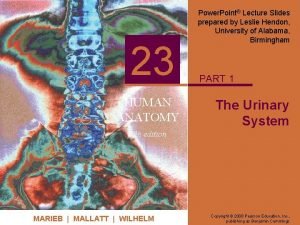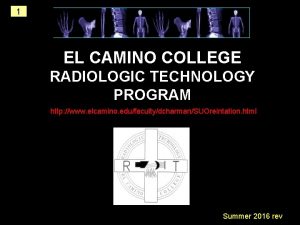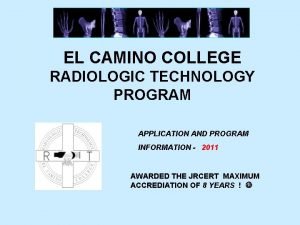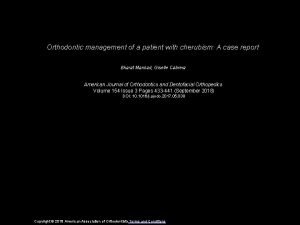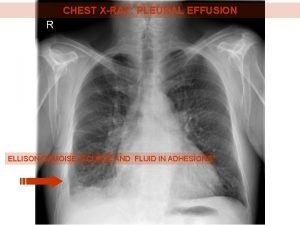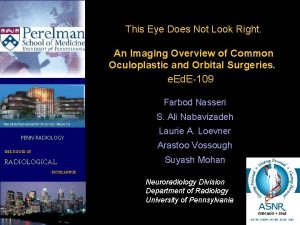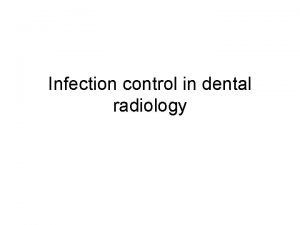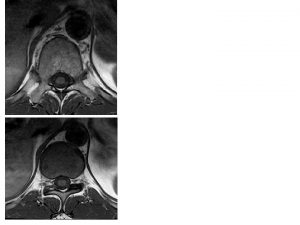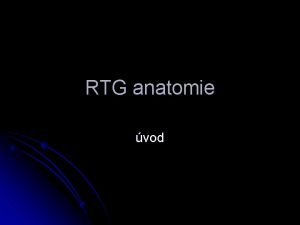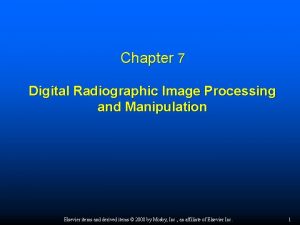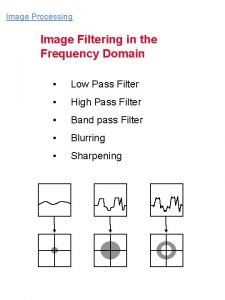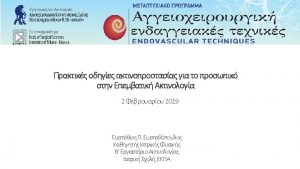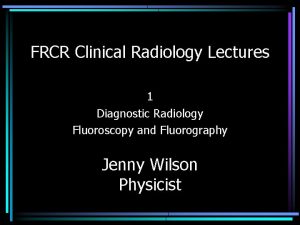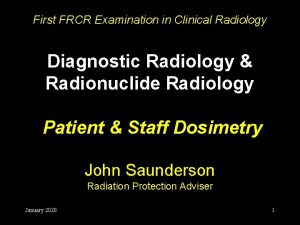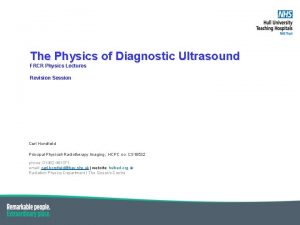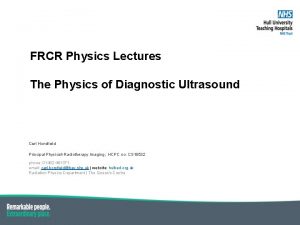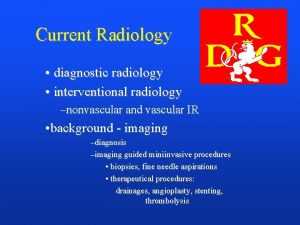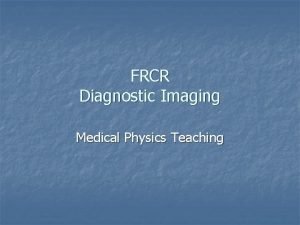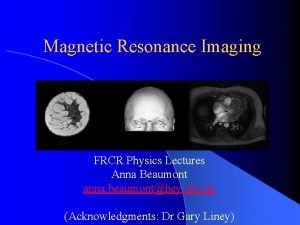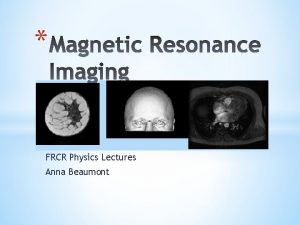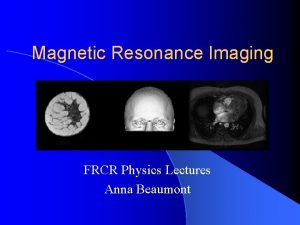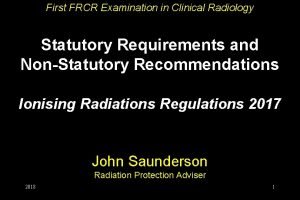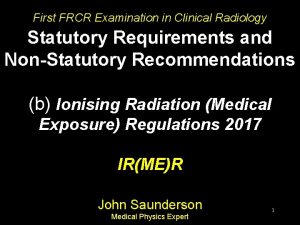FRCR Physics Lectures Diagnostic Radiology Lecture 1 An



































































































- Slides: 99

FRCR: Physics Lectures Diagnostic Radiology Lecture 1 An introduction to radiography with X-rays and the X-ray tube Dr Tim Wood Clinical Scientist

Lecture aims • Revision of the physics of x-ray interactions and production • Describe how the x-ray tube is constructed and understand the importance of each component • Basic understanding of x-ray generators • Explain what factors affect the output of an x-ray tube

INTRODUCTION

A little bit of history… • Wilhelm Röntgen discovered X-rays on 8 th Nov 1895 • Took first medical X-ray of wife’s hand (22 nd Dec 1895) • Used to diagnose Eddie Mc. Carthy’s fractured left wrist on 3 rd Feb 1896 (20 min exposure) • Awarded first Nobel Prize in Physics in 1901 for his discovery of ‘Röntgen rays’

A little bit of history…

Thankfully, things improved!…

What is diagnostic radiology? ra·di·ol·o·gy The science dealing with X-rays and other highenergy radiation, especially the use of such radiation for the diagnosis and treatment of disease Origin: 1895– 1900; radio- + -logy Related forms: ra·di·ol·o·gist, noun

What is diagnostic radiology? • The underlying principle of the majority of diagnostic radiological techniques is that X-rays display differential attenuation in matter – When the X-ray beam is targeted at a patient, the different tissues in the body will remove a different number of Xrays from the beam • The resulting modified X-ray flux can then be ‘captured’ by some form of detector to produce a latent image or radiation measurement – Detection may be through film, phosphor screens, digital detectors, etc

X-ray Properties • • Electromagnetic photons of radiation Emitted with various energies & wavelengths not detectable to the human senses Travel radially from their source (in straight lines) at the speed of light Can travel in a vacuum Display differential attenuation by matter The shorter the wavelength, the higher the energy and hence, more penetrating Can cause ionisation in matter Produce a ‘latent’ image on film/detector

Planar or three-dimensional? • Planar imaging is the most common technique used in diagnostic radiology – – General radiography e. g. PA chest Mammography screening Intra-oral dental radiography Fluoroscopy (but some modern ones can do 3 D) • The anatomy that is in the path of the beam is all projected onto a single image plane – Tissues will overlap and may not be clearly visible – Contrast is generally poorer than in 3 D imaging techniques

Planar or three-dimensional?

Planar or three-dimensional? 1 1 7 1 1 Subject contrast 7: 1 3 9 3 2 D image contrast 3: 1 2 D detector

Planar or three-dimensional? • 3 D imaging offers superior contrast to 2 D • More techniques are becoming available – Computed Tomography (CT), Cone beam CT, Tomosynthesis, etc • Compromise is that doses tend to be much higher than the planar image – e. g. CT chest = 6. 6 m. Sv c. f. PA chest = 0. 02 m. Sv (a factor of 330 difference!) • Hence, despite being less common, they account for a significant proportion of the UK populations exposure to medical radiation – CT accounts for 11% of examinations, but 68% of dose (HPA 2008 review)

X-ray interactions with matter • It is the physics of the interactions with matter that determine how each imaging technique works, and how it is used in clinical practice • So, a bit of revision…

Attenuation & imaging • Contrast in an image is generated by the differential attenuation of the primary X-ray beam • Scatter occurs in all directions, so conveys no information about where it originated – can degrade image quality, if it reaches film/detector

Attenuation • For a mono-energetic photon beam: where, I = final intensity, I 0 = incident intensity, µ = attenuation coefficient, x = thickness • Equal thicknesses of material reduce the intensity by the same fraction (half-value thickness).

Attenuation • Attenuation coefficient, µ, decreases with increasing photon energy (except for absorption edges) • Increases with atomic number of material, Z • Increases with density of material, ρ • Transmission of radiation @ 70 k. Vp; – 1 cm of soft tissue 66% transmitted – 1 cm bone 17% transmitted – 1 cm tooth 6% transmitted

Forward vs. Back-scatter • Forward scatter is most likely, but. . . • Forward scatter is attenuated by the patient, and • Deeper layers receive a smaller intensity, so there are fewer scattering events • Overall, see more back scatter. • Advantage for image quality (less scatter, but more attenuation at the detector), but may pose a risk in terms of radiation protection

Forward vs. Back-scatter

Interaction Processes • Elastic scattering • Photoelectric effect • Compton effect

Elastic Scatter • • Photon energy smaller than BE Causes e- to vibrate – re-radiates energy No absorption, only scatter < 10% of total interactions in diagnostic range i. e. not significant

Photoelectric Effect • Process of complete absorption • ~30% of interactions in diagnostic range • Energy is transferred to bound e-, which is ejected at a velocity determined by difference in photon and BE • e- dissipates energy locally, and is responsible for biological damage • Hence, main source of radiographic contrast (and dose), and why Lead is used in protection

Photoelectric Effect

Photoelectric Effect • Leaves atom in unstable state – electronic reconfiguration results in emission of X-ray or Auger electron • Auger emission more probable for low Z material – short range in tissue (= more biological damage) • Low energy X-rays reabsorbed locally • Rapid fall-off with increasing energy

Compton Effect • Process of scatter and partial absorption – inelastic scattering • Photon collides with a free electron (photon energy >> BE) • Loses small proportion of its energy and changes direction • Energy loss depends on scattering angle and initial photon energy • Photon free to undergo further interactions until completely absorbed (Photoelectric)

Compton Effect

Compton Effect • Compton scatter mass attenuation coefficient almost independent of energy over diagnostic range • Ratio of Z/A similar for most elements of biological interest (~0. 5) – offers little in terms of radiographic contrast

The Mass Attenuation Interaction Coefficient • Each process is independent – can add the interaction coefficients to give the total mass attenuation coefficient • Z dependence is the source of contrast in radiographic imaging

The Mass Attenuation Interaction Coefficient

The Mass Attenuation Interaction Coefficient

Maximising Radiographic Contrast • Maximise contrast due to Photoelectric absorption – use lower energy photon beams (note, it is the mean energy of the beam, not k. Vp that is important) • Use scatter rejection techniques such as scatter grids and air gaps • Limit beam to smallest area consistent with diagnostic task to minimise amount of scatter generated • BUT…

Maximising Radiographic Contrast • More Photoelectric absorption means higher patient dose • Scatter rejection techniques attenuate the primary beam, so a higher patient dose is required for acceptable image receptor dose • NEED TO BALANCE IMAGE QUALITY WITH PATIENT DOSE!!! • Hence, the principle of ALARA (As Low As Reasonably Achievable) – Use the highest energy beam that gives acceptable contrast, consistent with the clinical requirements

The X-ray tube

Generating x-rays • X-rays are produced when highly energetic electrons interact with matter • Require; – An electron source (cathode) – A target (anode) – Evacuated path to accelerate across – High voltage (20 -150 k. V) • However, most of the energy is given off as heat, and x-rays are thrown off in all directions – Require cooling and shielding The x-ray tube insert The generator The tube housing

A bit of revision… THE PHYSICS OF X-RAY PRODUCTION

The physics of X-ray production • Electron reaches the anode with kinetic energy equivalent to the accelerating potential (k. Vp) • Electrons penetrate several micrometres below the surface of the target and lose energy by a combination of processes – Large number of small energy losses to outer electrons of the atoms = heat – Account for about 99% of all energy dissipated from e- beam in the diagnostic range – Relatively few, but large energy loss X-ray producing interactions with inner shell electrons or the nucleus

Heat generating processes • When an electron (e-) strikes the target, most likely interaction is with loosely bound e-s that surround nuclei • Relatively weak interactions – slight deflection, ionisation or excitation • Small amount of energy transfer (per interaction) – observed as heat • However, accounts for ~99% of all energy dissipated from e- beam in the diagnostic range

Bremsstrahlung

Bremsstrahlung • Radiates energy in all directions, up to a maximum equivalent to k. Vp = continuous spectrum • High energy cut-off (≡ k. Vp) due to release of all energy in head on collision • Low energy cut-off due to self-attenuation by x-ray tube • >80% of X-rays produced are Bremsstrahlung (except for mammography)

Bremsstrahlung

Characteristic x-rays • Interactions with tightly bound e- (typically K-shell) • If energy of e- exceeds binding energy (BE) → ionisation • Vacancy leaves atom unstable – e- from higher state drops down, releasing X-ray photon (energy = difference in BE) • Gives characteristic peaks on X -ray spectrum that are specific to the target – For Tungsten target, Kα = 58 -59 ke. V and Kβ = 67 ke. V – Not observed below 70 k. Vp

Characteristic x-rays

The X-ray spectrum • Combination of Bremsstrahlung and characteristic x-rays yields characteristic spectrum 4. 00 E+05 60 k. Vp 80 k. Vp 120 k. Vp 3. 50 E+05 3. 00 E+05 Intensity 2. 50 E+05 2. 00 E+05 1. 50 E+05 1. 00 E+05 5. 00 E+04 0. 00 E+00 0 50 100 Energy (ke. V) 150

The X-ray spectrum • The peak of the continuous spectrum is typically one third to one half of the maximum k. V • The average (or effective) energy is between 50% and 60% of the maximum – e. g. a 90 k. Vp beam can be thought of as effectively emitting 45 ke. V X-rays (NOT 90 ke. V) • Area of the spectrum = total output of tube – As k. Vp increases, width and height of spectrum increases – For 60 -120 k. Vp, intensity is approximately proportional to k. Vp 2 x m. A

Controlling the X-ray spectrum – Exposure factors • Increasing k. Vp shifts the spectrum up and to the right – Both maximum and effective energy increases, along with the total number of photons • Increasing m. As (the tube current multiplied by the exposure time) does not affect the shape of the spectrum, but increases the output of the tube proportionately • k. V waveform – three-phase or high frequency generators will have more high energy photons than single phase. Hence, output and effective energy are higher

Quality & Intensity Definitions: • Quality = the energy carried by the X-ray photons (a description of the penetrating power) • Intensity = the quantity of x-ray photons in the beam • An x-ray beam may vary in both its intensity and quality

Quality • Describes the penetrating power of the X-ray beam, and is governed by the kilo-voltage (k. Vp) • Usually described by the Half-Value Thickness – i. e. the thickness (in mm) of Al required to half the beam intensity for a given k. Vp • Typically >2. 5 mm Al for general radiography • Changing the quality of the beam will change the contrast between different types of tissue. • A highly penetrating beam is referred to as ‘Hard’ and a poorly penetrating beam as ‘Soft’

Intensity • Intensity - is the quantity of energy flow onto a given area over a given time; the ‘brightness’ of an x-ray beam • The tube current (m. A) is a measure of X-ray beam intensity • Intensity is directly proportional to m. A. – i. e. Double the m. A, double the dose (quality not affected) • Intensity is also affected by k. Vp

The mechanics of making an x-ray THE X-RAY TUBE

X-ray tubes – an overview • The x-ray tube insert is where we make the x-rays used in x-ray imaging systems – Cathode, anode, glass/metal enclosure under vacuum • The x-ray tube housing supports and shields the tube insert • The x-ray generator supplies the power • k. V, m. A and exposure time are selectable by the operator

THE X-RAY TUBE INSERT

The cathode • The negative electrode – Composed of a filament (source of electrons) and a focussing cup – Often have two filaments for broad and fine focus • Filament heating current applied (approx. 10 V, 7 A) • Process of thermionic emission releases electrons from the surface of the filament – Heat up to ~2200°C – ‘Free’ electrons in the metal gain enough energy to overcome the binding potential – Tungsten metal is ideal material • Need to apply high voltage to move these electrons across to the anode

Electron production in the X-ray tube k. V Applied voltage chosen to give correct velocity to the electrons m. A Filament (heats up on prep. ) + Target

The anode • Metal target electrode, held at a large positive potential difference relative to the cathode • Electrons strike the anode and convert kinetic energy to mostly heat, with relatively few x-rays released – So to get an acceptable output from the tube, a lot of heat must be generated that has to be dealt with – Don’t want to blow the tube up! • Limits are placed on exposure factors to avoid damage • Choice of material important – Alloys of 10% rhenium and 90% tungsten are resistant to surface damage – good for general x-ray tubes • Also other design features used to limit heat damage…

Stationary or rotating? • Simple x-ray tubes (e. g. dental) have tungsten insert on a solid copper block – Conducts heat away from focal spot – Limited to low tube currents as heat builds quickly • Rotating anodes used for most diagnostic applications Bevelled disc on a rotor assembly Spins 3, 000 -10, 000 rpm Spread the heat out over a large area Allows greater loading and higher x-ray output – Tube does not energise until the disc is up to speed – Cooled via radiative emission transferring heat to tube insert and surrounding oil bath – –

The rotating anode

The rotating anode

Anode angles • The x-ray generating surface of the anode is angled (7 -20⁰) • Actual focal spot is the area of anode struck by electrons • Apparent focal spot size is much smaller due to geometry – Heat spread out over a large area without affecting resolution

Anode angles • Smaller angles allow greater tube loading and finer resolution • BUT, limits maximum field size due to cut-off on anode side • Focal spot size varies across the image field – Anode side = shorter effective focal spots – Cathode side = elongated effective focal spot • Optimal target angle depends on clinical application

The focal spot • Typical focal spot sizes are – – 0. 15 -0. 3 mm for mammography 0. 6 -1. 2 mm for general radiography 0. 6 mm for fluoroscopy 0. 6 -1. 0 mm for CT

The anode heel effect • Ideally, the X-ray beam would be uniform across whole image • However, this is not the case due to the anode heel effect – The steeper the target angle, the worse the effect • The electrons penetrate a few micrometres below the surface of the anode before generating X-rays – Hence, the X-rays that are generated in the target may be attenuated on their way out • X-rays travelling towards the anode edge of the field (A) will pass through more of the target before exiting the tube – Hence, attenuation will be greater on this edge, and beam intensity will be lower than on the Cathode side of the field (B) – Roughening of the anode surface as the tube ages make this worse • Generally noticeable on most images • Can be minimised by using greater focus-to-detector distances, smaller fields and shallower target angles

The anode heel effect

Geometric unsharpness and the focal spot • Spatial resolution is dependent upon : – Geometrical unsharpness – Motion unsharpness – Absorption unsharpness • Geometric unsharpness is related to the fact that we cannot (and in fact do not want to) produce an ideal point source of X-rays – The focal spot of the X-ray tube has a finite size that results in blurring across the edge of structures – Can be reduced by using a smaller focal spot, decreasing the object-film distance (OFD) or using a longer focus-tofilm distance (FFD)

Geometric unsharpness – The ideal point source Ideal point source of X-rays FFD Object OFD Film/detector

Geometric unsharpness – A ‘real’ focal spot Focal spot of finite size, f FFD Object OFD Film/detector Penumbra

Geometric unsharpness and the focal spot • So, to minimise geometric unsharpness – The smallest focal spot should be used, especially if magnification imaging is to be performed (but be careful not to blow the tube!) – The patient should be positioned as close to the detector as possible (unless magnification imaging) – Largest possible focus-to-detector distances to reduce magnification and blurring (within practical limits!)

Geometric unsharpness – A ‘real’ focal spot Focal spot of finite size, f FFD Object Film/detector

X-ray tube design – dual focus

THE X-RAY TUBE HOUSING

The tube housing • Supports, insulates and protects the tube insert • Oil surrounds the insert for cooling and electrical insulation – Expansion bellows often fitted to prevent exposure if the oil (and hence tube) gets too hot – Some tubes have heat exchangers to actively cool the oil • Lead shielding is fitted around the tube housing to attenuate all x-rays not directed at the tube port – A small fraction of these will escape – known as leakage radiation – Legal limits on how much leakage is allowed

Collimators • Adjust the size and shape of the x-ray beam • Two pairs of parallel blades of high attenuation material that can be adjusted to define the required rectangular field size • Has a light beam system for visualisation

Filtration • Filtration is the removal of x-ray photons as the beam passes through material • The x-ray tube has inherent filtration due to the anode, glass/metal envelope, cooling oil, etc • Added filtration is the sheets of metal deliberately inserted in the beam to reduce the number of low energy photons in the beam – Reduce the dose to the patient – Minimum standards on how much should be present in the beam (depending on application) • Can also have beam shaping filters to compensate for patient shape and to equalize the signal on the detector e. g. ‘bow-tie’ filters in CT

X-RAY GENERATORS

Transformers • The x-ray generator provides the high voltage to the x-ray tube (20, 000 -150, 000 Volts) • Transformers are used to convert low voltage (from a mains supply) into a high voltage through electromagnetic induction • Input AC power on the primary windings, induces a voltage on the secondary windings that is proportional to the input voltage and ratio of the number of turns

Transformers • However, to accelerate electrons across the tube, need anode to always be positive relative to cathode – AC waveforms change polarity every half-cycle • Rectifiers can prevent this • The high frequency generator is the now the most common type of generator – Takes a low voltage, low frequency input and converts to low voltage DC via rectifier and smoothing – An inverter creates a high frequency AC waveform from this – A transformer creates the high voltage – Rectified and smoothed again to provide high voltage DC to tube • A number of feedbacks are continuously checked during exposure to ensure appropriate k. V and m. A

High frequency x-ray generator

Ripple • Ideal voltage would be constant • Real voltages tend to vary, and this depends on the type of generator used • Ripple describes variation in k. V during exposure – Single phase = 100% ripple – High frequency = low ripple • Ripple reduces the output of the x-ray tube compared with what would otherwise be expected

The operator console • The operator can select tube voltage (k. V), tube current (m. A), exposure time (s) or the product of m. A and time (m. As) • Focal spot selections on some systems – Choice depends on resolution requirements vs damage to x-ray tube • May also have controls for the automatic exposure control – The AEC determines how long exposures should be based on the transmission of x-rays through the subject • Pre-programmed techniques can also be found on the operator console • In fluoroscopy, manual k. V and m. A control not practical, so automatic control systems are used

The operator console

Automatic exposure control • AEC measures amount of radiation incident on the detector and terminates exposure when a pre-defined limit is reached • Compensates for different size patients and variations in attenuation • Can have some measure of manual control by using ‘fine density’ controls to force the system terminate a little earlier or later, depending on image quality requirements • Usually have a choice of ion chambers that can be selected in different configurations depending on clinical application – e. g. central chamber, left-right chambers, all three chambers

Automatic exposure control

Power ratings, heat loading and cooling • Power rating is the maximum power that a tube focal spot can accept or the generator deliver – Small focal spots have lower ratings than large focal spots • Power ratings vary significantly and depend on the modality being used • Heat Units are a simple way of expressing energy deposition and dissipation in the anode • Anode heating and cooling charts show heat loading for various

Heat rating • k. V, m. A and exposure time should be such that the temperature of the anode does not exceed its safe limit – The control system is designed to prevent exposures that exceed the tube rating • Require much higher tube ratings for CT and interventional fluoroscopy units

FACTORS AFFECTING X-RAY TUBE OUTPUT

X-ray tube output • Output of an x-ray tube can be described in terms of; – Quality: Penetrating power of x-ray beam (HVL) – Quantity: Number of photons in x-ray beam • Six major factors determine x-ray tube output; – – – Anode target material Tube kilovoltage Tube current Exposure time Beam filtration Generator waveform

Target material • The efficiency of Bremsstrahlung production depends on the atomic number of the anode material – Incident electrons more likely to interact with high Z materials • The anode material also determines the energy of the characteristic x-rays • Target material affects both quantity and quality of the x-ray beam

Tube kilovoltage • Determines maximum energy of the x-ray beam – Affects quality of beam • Efficiency of x-ray production also affected – Quantity • Exposure ∝ k. V 2 • Increasing k. Vp increases efficiency (quantity) and quality of the beam • Must change m. As alongside to compensate for changing output of the x-ray tube

The X-ray spectrum

Tube current and exposure time • Proportional to the number of electrons flowing from cathode to anode • Therefore directly proportional to number of x -rays produced – Quantity • Exposure time is how long the beam is on for – Quantity • Quantity of x-rays is directly proportional to the exposure factor (m. As) • Beam quality not affected

Beam filtration • ‘Soft x-rays’ contribute to patient dose without contributing to image production • Placing Al filters in the beam will increase beam quality – this is known as ‘Beam Hardening’ – Alternative materials may be used for filtration in specialised applications e. g. mammography (Mo, Rh, Ag) and fluoroscopy (Cu) • Lowest energy photons are most readily absorbed as photoelectric absorption dominates (proportional to the E 3) • As the beam passes the Al, the proportion of low energy photons is reduced, and the average photon energy increases

Filtration

Beam filtration • Modifies the quantity and quality of the x-ray beam by preferential absorption of the low energy x-rays – Reduce the number of xray photons – Increases mean energy of the beam

Filtration

Beam filtration • Hence, Patient dose is reduced with little affect on the radiation reaching the detector • However; • Radiographic contrast is reduced due to the higher mean energy of the beam • Greater exposure factors required to yield satisfactory dose at film/detector (have to drive the tube harder, and hence tube life may be reduced) • The X-ray beam is also filtered by the target that they are produced in, the coolant oil and the window of the housing • ‘Inherent filtration’ equivalent to about 1 mm Al

Generator waveform • Affects the quality and quantity of the beam – A single phase generator has a lower potential difference than a highfrequency generator – High ripple gives lower quality and tube output

Focus-to-skin Distance: The Inverse Square Law • For a point source, and in the absence of attenuation, intensity decreases as the inverse of the square of the distance • This is a statement of the conservation of energy

The inverse square law • Patient dose can be significantly reduced by increasing the distance to the X-ray tube – FSD < 45 cm should not be used (<60 cm for chests – 180 cm used in practice)

SUMMARY

Summary • X-rays are generated in the x-ray tube • A broad spectrum of energies are produced through Bremsstrahlung and characteristic x-rays • Heat generation is a significant problem in the xray tube • A number of factors affect the output of the x-ray tube, and these must all be considered and understood to enable the best possible image to be acquired (for the minimum radiation dose to the patient)
 Frcr physics lectures
Frcr physics lectures Frcr physics lectures
Frcr physics lectures Diagnostic radiology department
Diagnostic radiology department 01:640:244 lecture notes - lecture 15: plat, idah, farad
01:640:244 lecture notes - lecture 15: plat, idah, farad Physics 101 lecture notes pdf
Physics 101 lecture notes pdf Physics 111 lecture notes
Physics 111 lecture notes Wave motion definition
Wave motion definition Physics 101 lecture
Physics 101 lecture Atmospheric physics lecture notes
Atmospheric physics lecture notes Phy101 lecture 1
Phy101 lecture 1 Ludic space
Ludic space Cern summer student lectures
Cern summer student lectures 13 lectures
13 lectures Medical emergency student lectures
Medical emergency student lectures Orthopedic ppt lectures
Orthopedic ppt lectures Oral communication 3 lectures text
Oral communication 3 lectures text Theory of translation lectures
Theory of translation lectures Dr sohail lectures
Dr sohail lectures Anatomy lectures powerpoint
Anatomy lectures powerpoint Ota core curriculum
Ota core curriculum Trend lectures
Trend lectures Nuclear medicine lectures
Nuclear medicine lectures Lectures paediatrics
Lectures paediatrics Cs106b lectures
Cs106b lectures Pathology lectures for medical students
Pathology lectures for medical students Software project management lectures
Software project management lectures Medicine hematology student lectures
Medicine hematology student lectures Reinforcement learning lectures
Reinforcement learning lectures C programming and numerical analysis an introduction
C programming and numerical analysis an introduction Power system lectures
Power system lectures Digital logic design lectures
Digital logic design lectures Utilities and energy lecture
Utilities and energy lecture Cern summer school lectures
Cern summer school lectures Comsats virtual campus lectures
Comsats virtual campus lectures Theory of translation lectures
Theory of translation lectures Data mining lectures
Data mining lectures Cs106b lectures
Cs106b lectures Guyton physiology lectures
Guyton physiology lectures Dr asim lectures
Dr asim lectures Molecular biology lecture
Molecular biology lecture Rcog eportfolio
Rcog eportfolio Haematology lectures
Haematology lectures Theory of translation lectures
Theory of translation lectures Compsci 453
Compsci 453 Web engineering lectures ppt
Web engineering lectures ppt Hugh blair lectures on rhetoric
Hugh blair lectures on rhetoric Reinforcement learning lectures
Reinforcement learning lectures Bba lectures
Bba lectures Medicinal chemistry lectures
Medicinal chemistry lectures Cdeep lectures
Cdeep lectures Aerodynamics lecture
Aerodynamics lecture Radio astronomy lectures
Radio astronomy lectures Ota resident lectures
Ota resident lectures Bhadeshia lectures
Bhadeshia lectures Bureau of lectures
Bureau of lectures Translation 1
Translation 1 Rick trebino
Rick trebino Hegel classical art
Hegel classical art Do words have power
Do words have power University physics with modern physics fifteenth edition
University physics with modern physics fifteenth edition Physics ia topics
Physics ia topics Modern physics vs classical physics
Modern physics vs classical physics El camino college radiology
El camino college radiology Radiology mergers and acquisitions
Radiology mergers and acquisitions Mallinckrodt institute of radiology
Mallinckrodt institute of radiology El camino rad tech
El camino rad tech Sialography technique
Sialography technique Gonad shielding
Gonad shielding Cherubism radiology
Cherubism radiology Main chain scission radiology
Main chain scission radiology Sacred seven assessment
Sacred seven assessment Jessie qian
Jessie qian Oid in radiology
Oid in radiology Cherry blossom appearance on sialogram
Cherry blossom appearance on sialogram Fossa rosenmuller
Fossa rosenmuller Ellis curve on chest x ray
Ellis curve on chest x ray Oral medicine and radiology day
Oral medicine and radiology day Uva radiology tutorial
Uva radiology tutorial Kestral karisma
Kestral karisma Sami natour
Sami natour Grid errors radiography
Grid errors radiography Bronchiectasis radiology
Bronchiectasis radiology Uk competition ratio
Uk competition ratio Vision radiology reservoir
Vision radiology reservoir Darkroom infection control guidelines
Darkroom infection control guidelines Monocacy health partners patient portal
Monocacy health partners patient portal Corpus callosum anatomy radiology
Corpus callosum anatomy radiology Veterinary radiology dallas county
Veterinary radiology dallas county Oklahoma state radiology residency
Oklahoma state radiology residency Angiofibroma nasofaring
Angiofibroma nasofaring Radiology alert system
Radiology alert system Scottish radiology transformation programme
Scottish radiology transformation programme Tor cdr
Tor cdr Basion opisthion line radiology
Basion opisthion line radiology Bilbao dotter tube radiology
Bilbao dotter tube radiology Veil glare radiology
Veil glare radiology Bno ivp radiology
Bno ivp radiology Frequency domain image
Frequency domain image Lens
Lens Pa dental radiology ce requirements
Pa dental radiology ce requirements


















